2023 MFA Graduation Exhibition
Through May 6
Free
USF Contemporary Art Museum
Details here
Growing up in Michigan, I began recognizing natural and cultural markers dotting the yearly cycles. Crocuses pushing up through the melting snow in spring, various holidays, the Moon phases, anticipation of birthday gifts…
Here’s the first verse of Joni Mitchell’s 1966 song, “The Circle Game” –
“Yesterday a child came out to wander
Caught a dragonfly inside a jar
Fearful when the sky was full of thunder
And tearful at the falling of a star
And the seasons they go round and round
And the painted ponies they go up and down
We’re captive on the carousel of time
We can’t return we can only look
Behind, from where we came
And go round and round in the circle game
Then the child moved ten times round the seasons…”
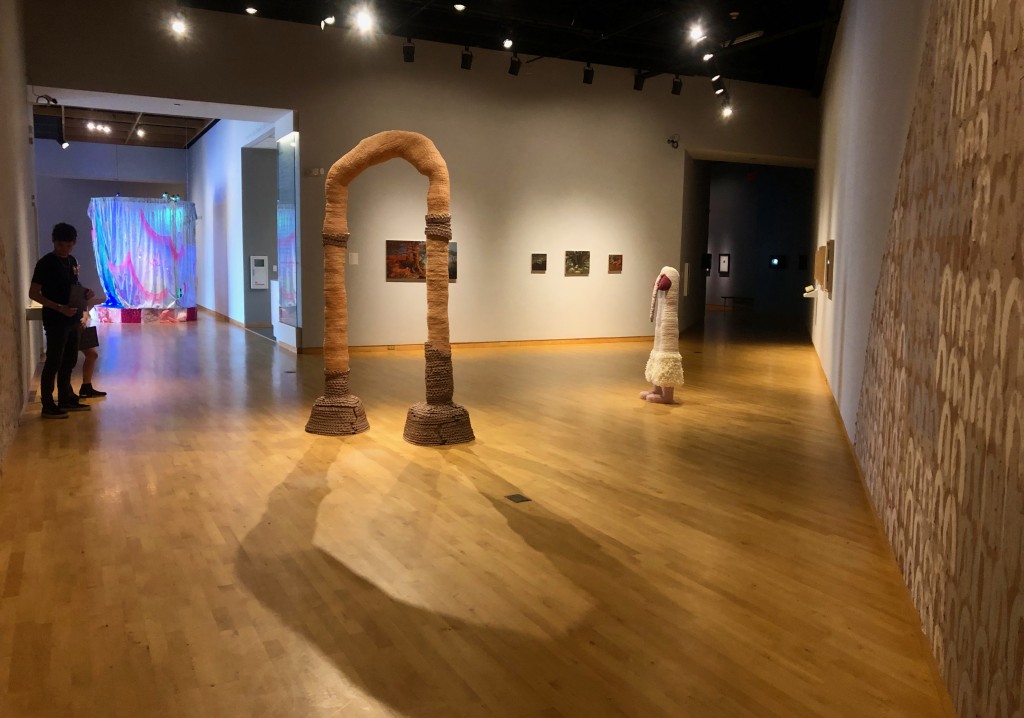
Now here in Florida, of the many annual events, one cultural marker is the MFA graduation exhibition at the University of South Florida Contemporary Art Museum.
This year is the 17th season, and as Wallace Willson, Director of the USF School of Art and Art History details in the exhibition brochure – “Since its inception, more than 100 students have been featured…
“For three years, these exceptionally imaginative students have engaged our distinguished faculty and endured challenging critique sessions as well as sleepless nights preparing for semester reviews. They have stretched well beyond their initial perception of what art could be and its impact on an audience.”

And with that, exhalation and exhilaration. Champagne toasting exaltation with friends and family from near and far for the culminating celebration to the finality of this academic life – and commencement of the next existential journey.
It is no small feat arriving at this threshold.
A small Pythagorean numbers tangent about this 17th season – in numerology, 1 + 7 = 8, which accordingly “…the power and strength associated with number 8 are said to be feminine energy…” Serendipitously, the eight artists in this exhibition are all women.
The exhibition titled Someday You’ll Have To Say It Out Loud features Molly A. Duff, Kai Holyoke, Caitlin Nobilé, Trinity Oribio, Rachel Treide, Manon VanScoder, Alicia Watkinson and Willow Wells.
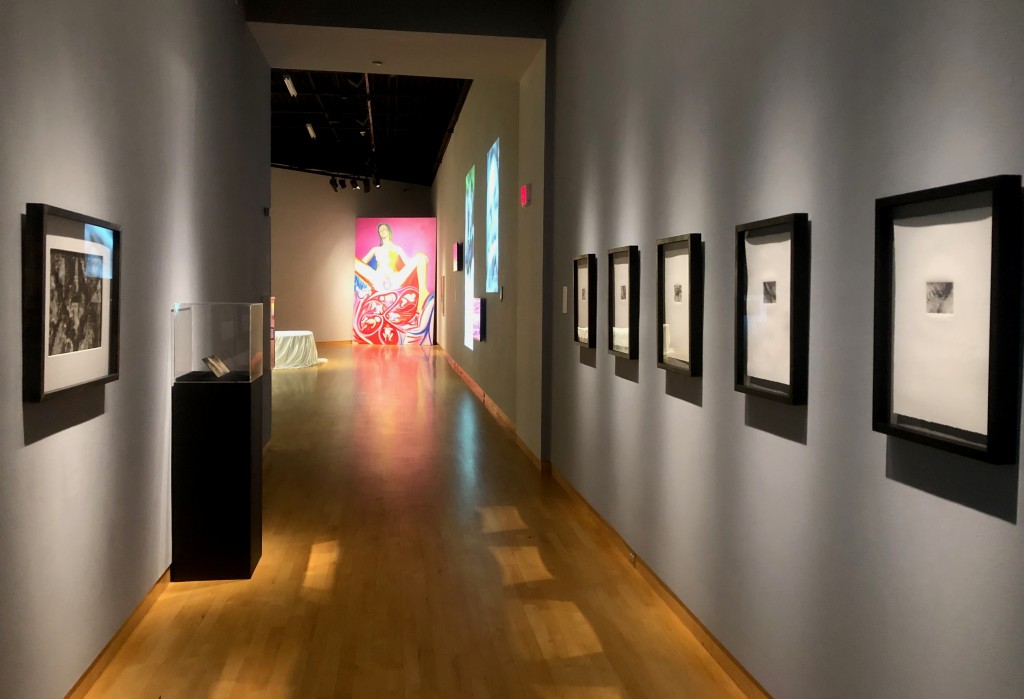
And quite a show it is.
There’s big drama, quiet reflections, works that can fit in the palm of your hand and installations enveloping the whole body, primitivism balancing digital technology – and all questioning identity as boundaries are crossed.
From the earliest humans stenciling their handprint onto cave walls, people have always left a record of their existence using whatever materials and technology available. So it is interesting to view this exhibition as a condensed summary of the evolving culture and methods.
Art making history in a nutshell – looking backwards, from latest to earliest. . .
– Programming digital memory chips that feed Manon VanScoder’s (Is there a more apt name?) various screen displays
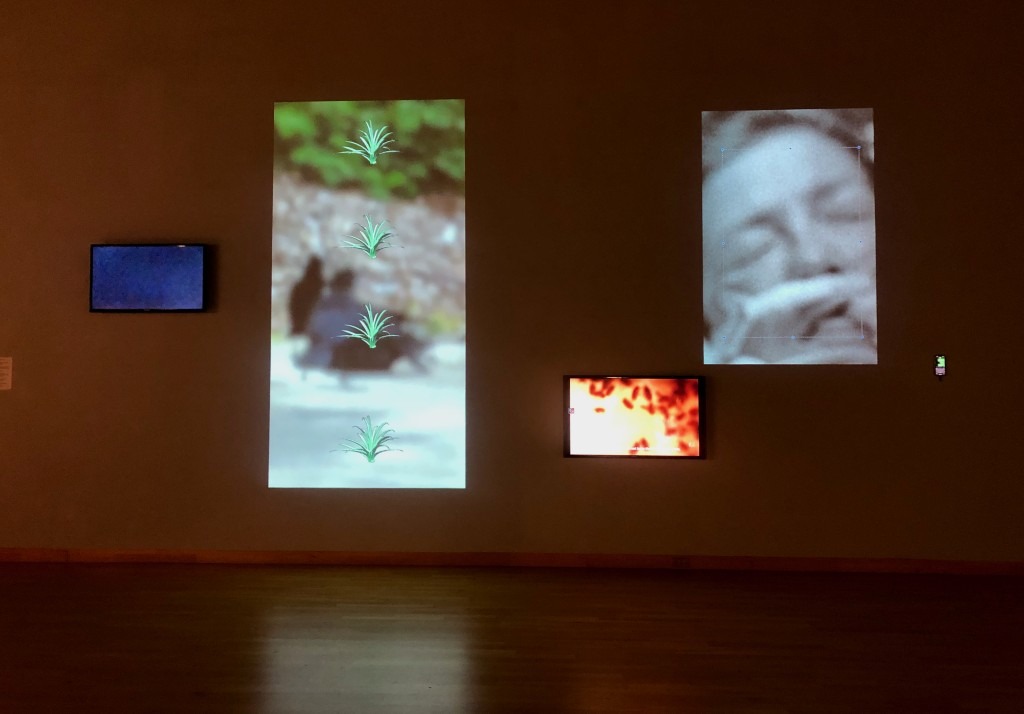
– Alicia Watkinson’s bare light bulbs atop minimal Donald Judd forms randomly turning on and off
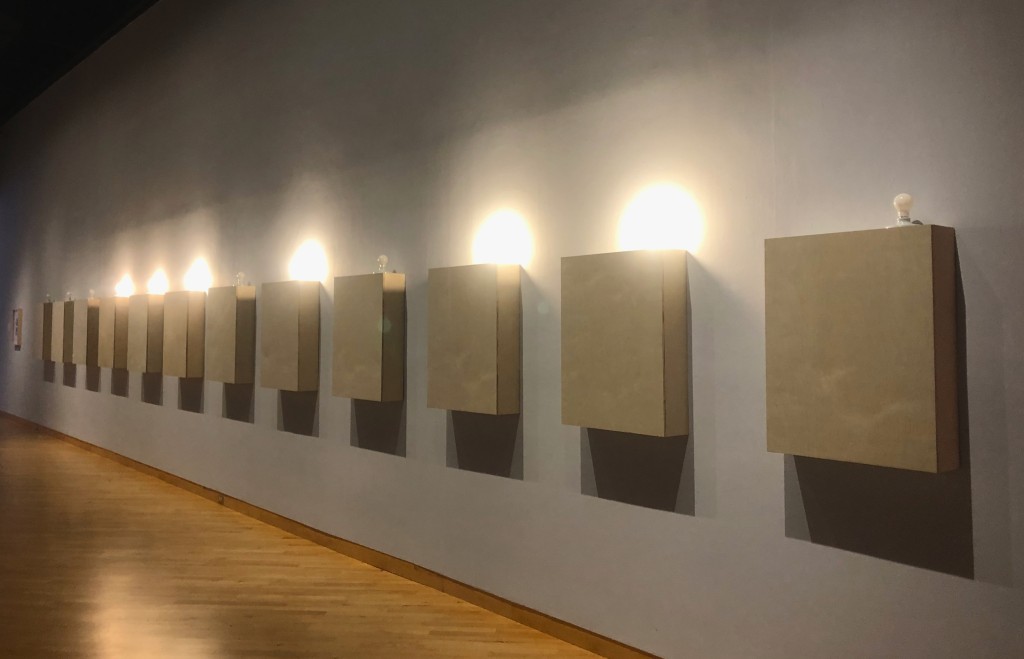
– Details of our natural planet captured in Rachel Treide’s camera lens
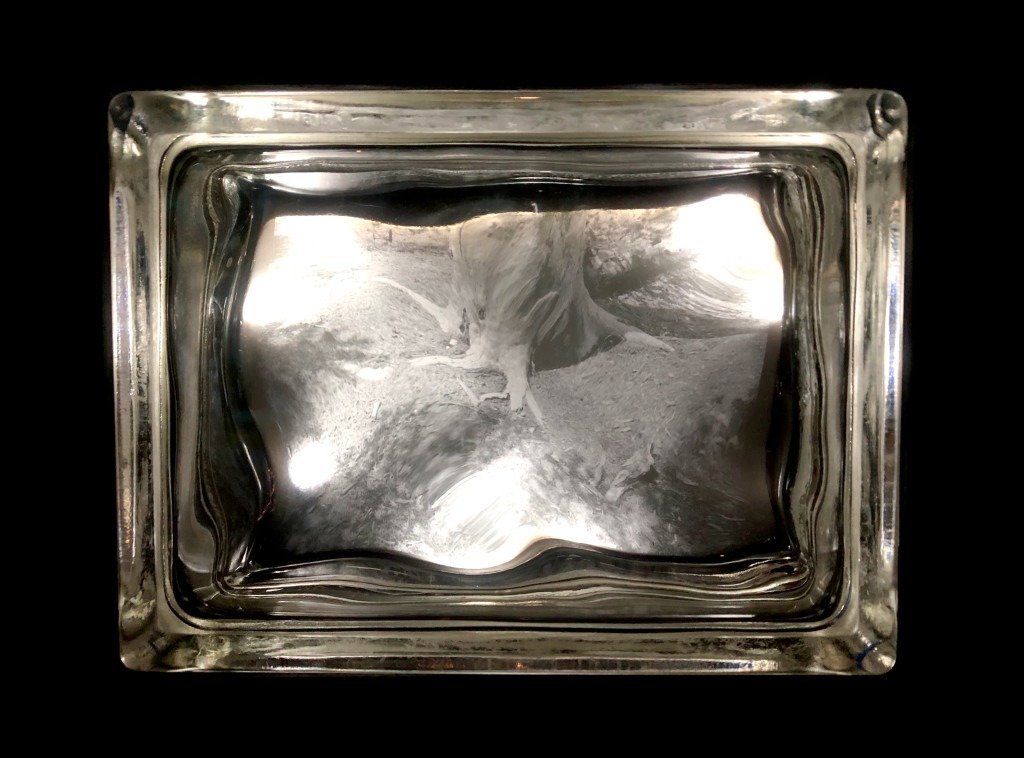
– The printing presses producing Molly A. Duff, Rachel Treide and Willow Wells’ edition prints and books
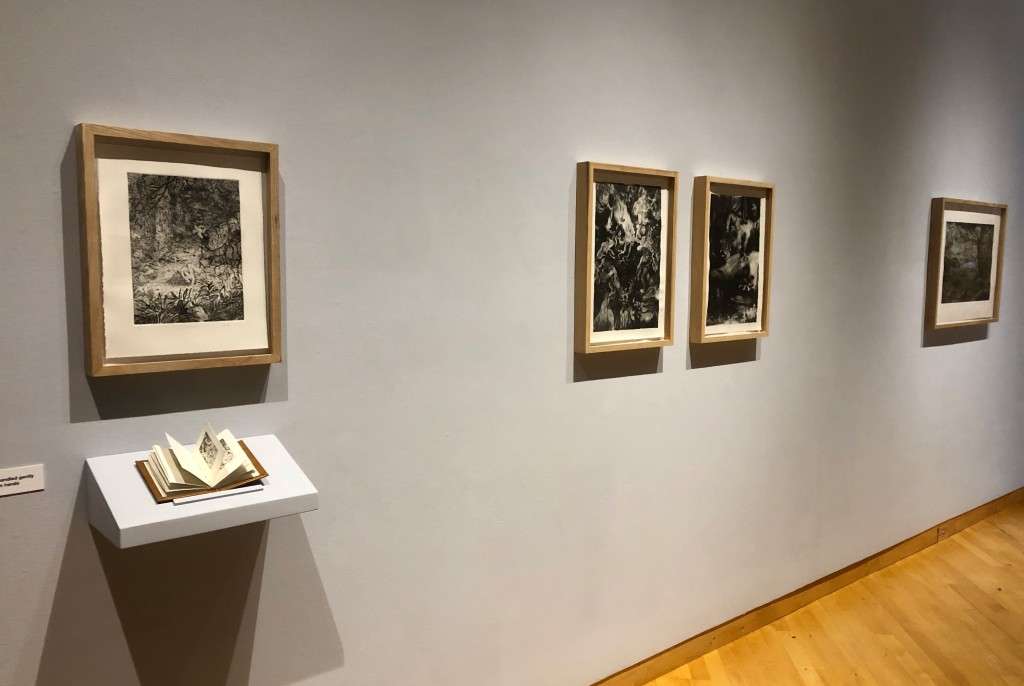
– The human presence on Willow Wells, Caitlin Nobilé and Trinidad Oribio’s painted canvases – a means of recording and conveying ideas before widespread literacy and invention of the camera
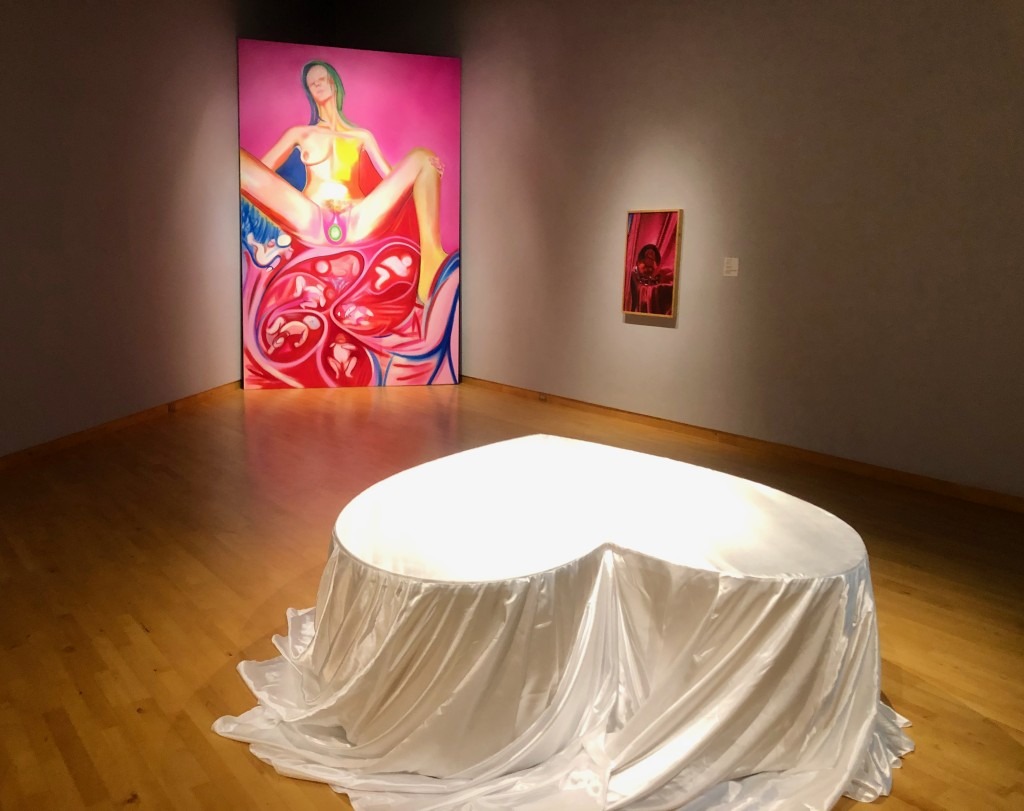
– The staged scenes in Kai Holyoke’s kitschy burlesque tableaus – after the Greek theater and oral traditions of telling stories and transmitting history
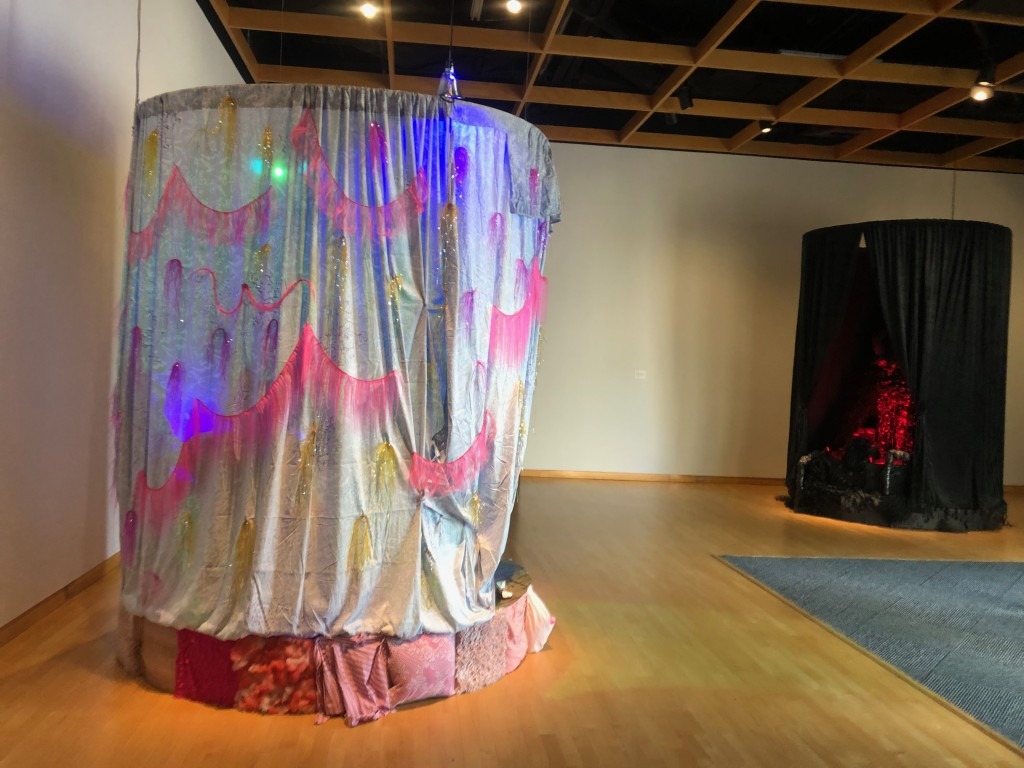
– Fundamental mark making in Molly A. Duff’s wall (cave) paintings of dense fields of upside down U shapes, which if we go to the other side of the world, will find that the Australian aboriginal people have long used the U shape to represent people in their visual library of motifs and symbols
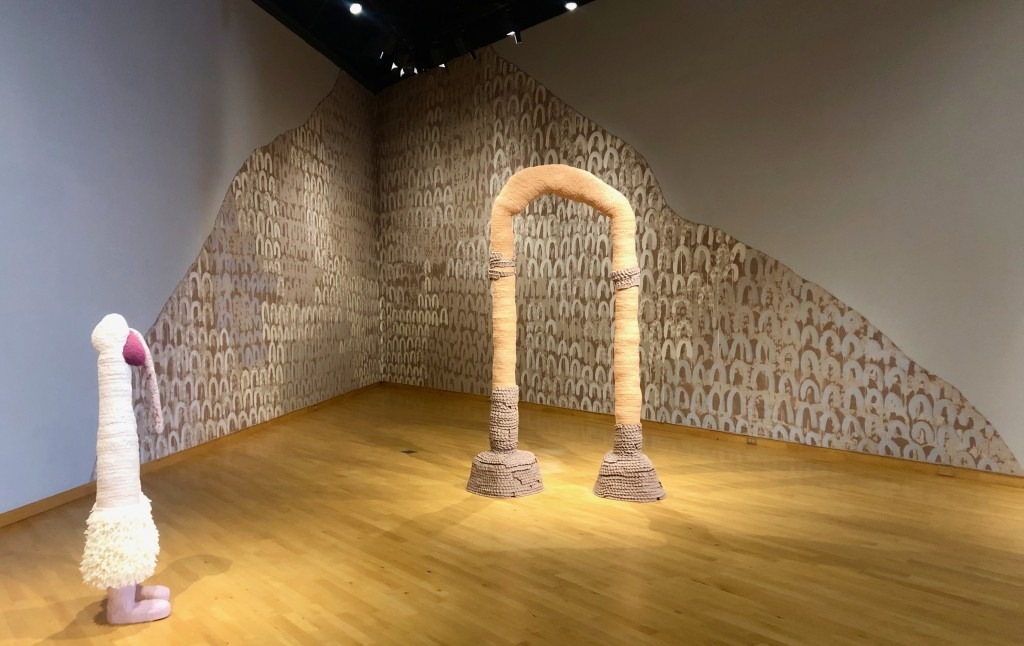
Phew, that’s a long and wide expanse.
From childhood, we’re endlessly fascinated with our bodies figuring out all the appendages, orifices and functions, from grasping everything within reach and stuffing it in our mouths, to learning balance and walking, experiencing pleasures, pains, to interfacing societal codes and mores, to evolving mental musings and philosophical abstractions.
The eight artists’ works can be roughly distilled to figurative, landscape, and social experimentation classifications, with many obvious overlapping boundaries.
Figurative
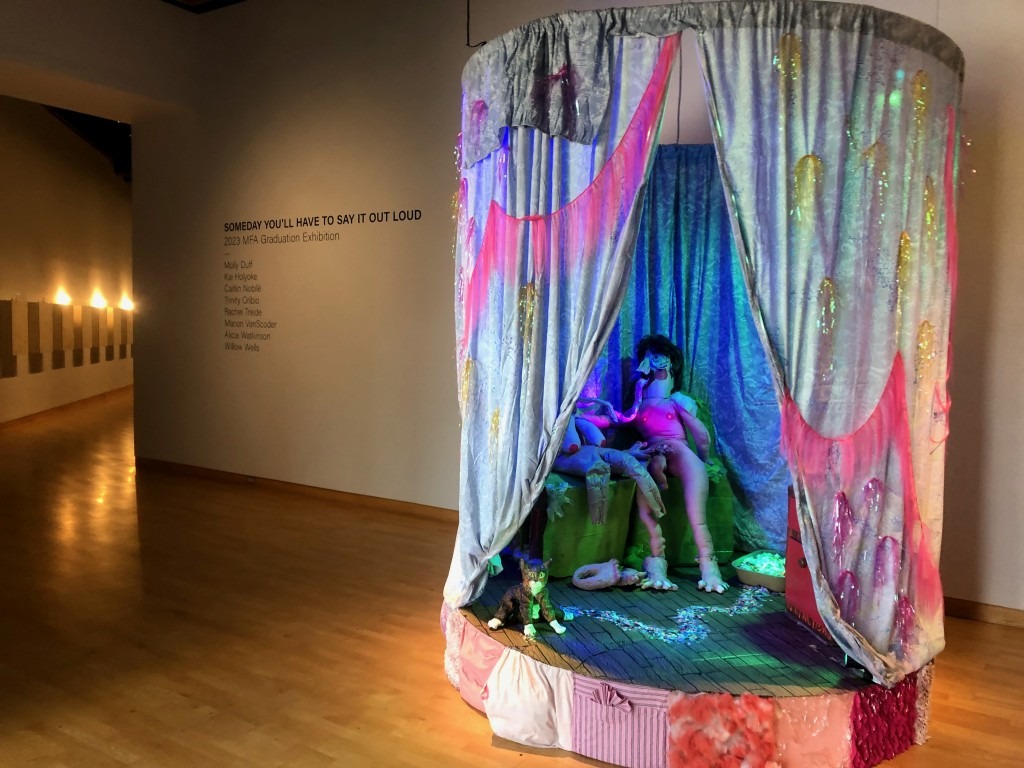
Trinidad Oribio and Kai Holyoke are direct and graphical. Contrasting the more full-figured fertility goddesses of ancient times, Oribio’s large painting of a skinny fertility goddess stands in the gallery apex with a revolving heart-shaped platform which could be an altar for sacrifice, or a cake that a dancer could pop out of any minute.
Holyoke’s Big thoughts Silly objects… with soundtracks in two round curtained stages in crude temporal racy handmade itinerant folk theater fashion, as in a fringe festival before moving on only to return next season. More subtle are Willow Wells’s people trees which “…meld figures and plants into cohesive forms that are meant to give the work a sense of ‘in-between’ male and female, and plant and human.”
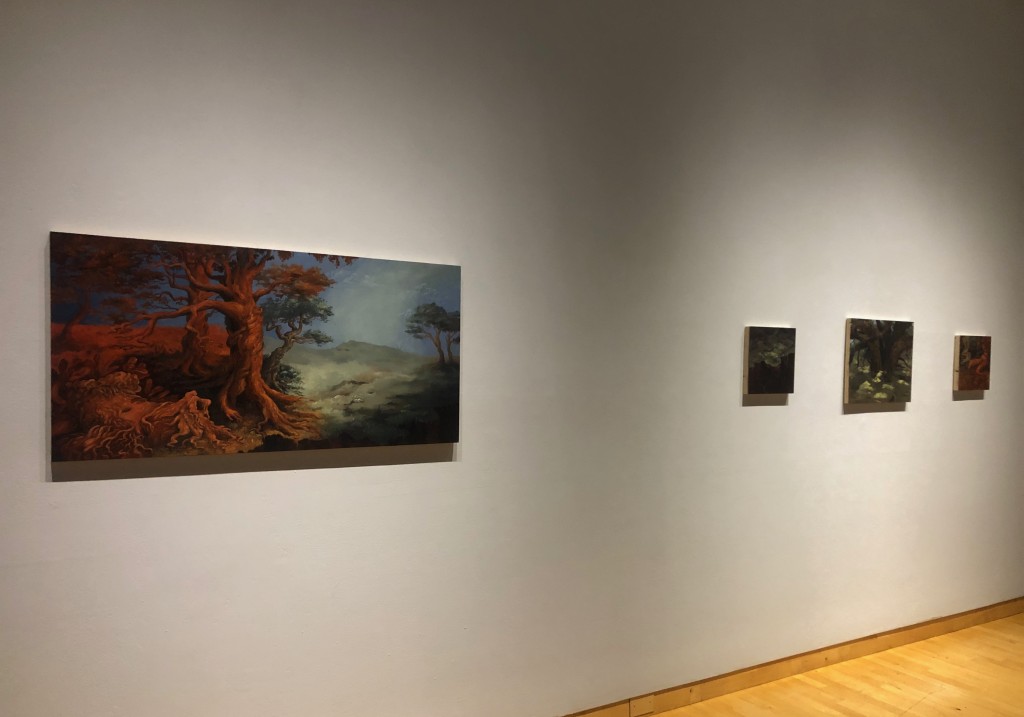
And Molly A. Duff’s more myth-making stories pulling materials directly from the Earth for her sculptures and mud paintings.
Landscape
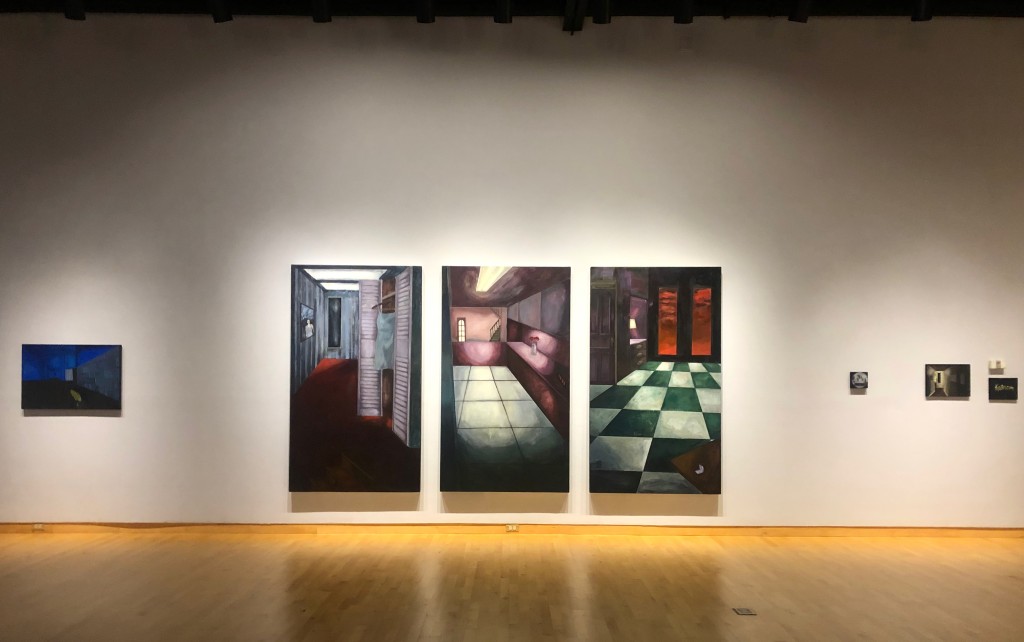
Interior and exterior landscapes, the stage and backdrop to our unfolding life, and sometimes the subject itself as painted by Caitlin Nobilé of computer gaming interiors, maybe surrogates of mental states.
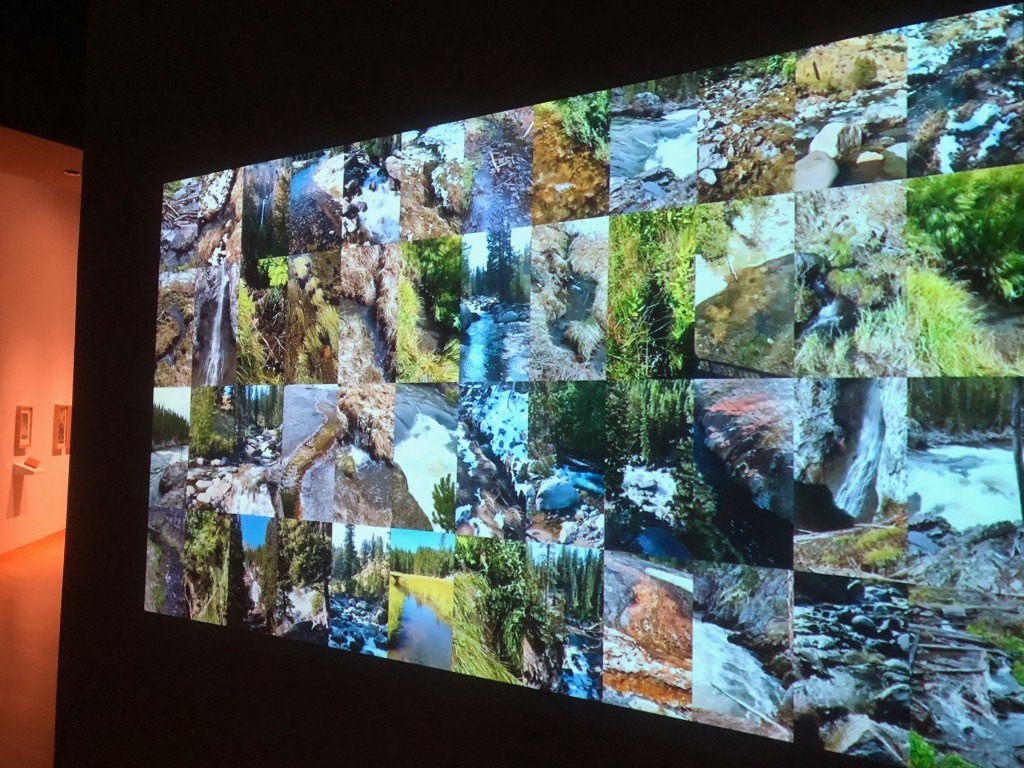
Willow Wells’ Constable-esque trees that seem to represent something else. Rachel Treide’s close-up shots of the messiness of nature, both actual and perceived, with a video wall of waterfalls, a hypnotic collage of many Instagrammable memories.
Social Experimentation
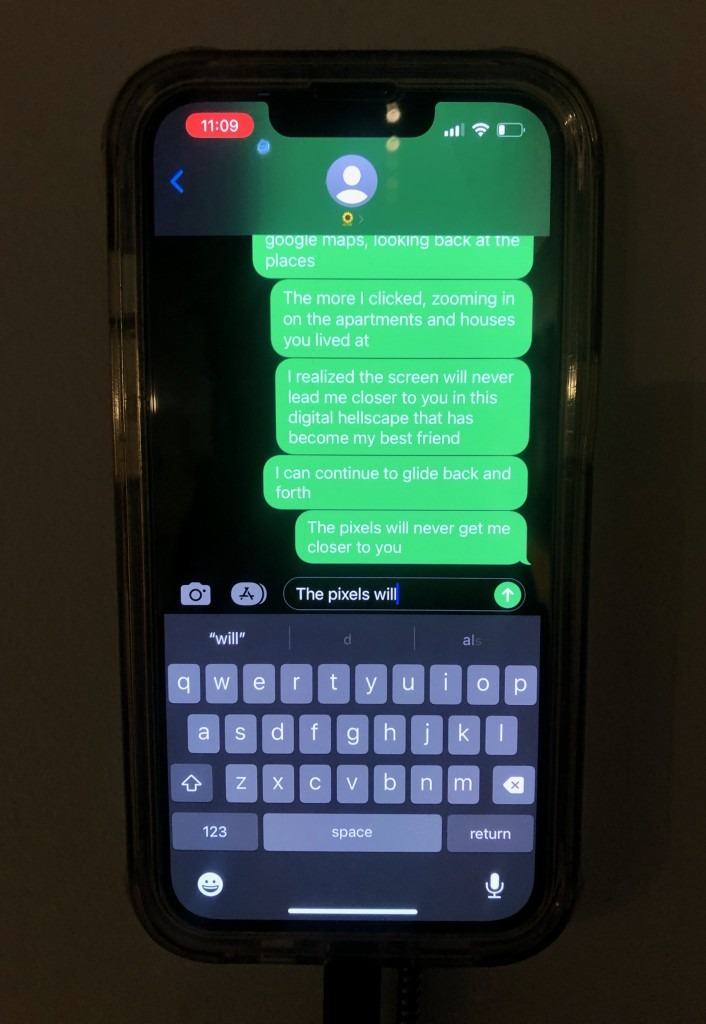
These delve into those daily philosophical moments. . .
Alicia Watkinson’s mysterious light show as explained in the label – “Duration of light set according to previous day’s activities and observations” – which sounds like clandestine behavioral mining.
Manon VanScoder looking for meaning in this frantic contemporary existence, making the ultimate memento mori statement – with a portrait of what looks like a dead person.
Performative Kai Holyoke is the most direct of all experimentations creating uncanny realities that while entertaining, may not sit comfortable.
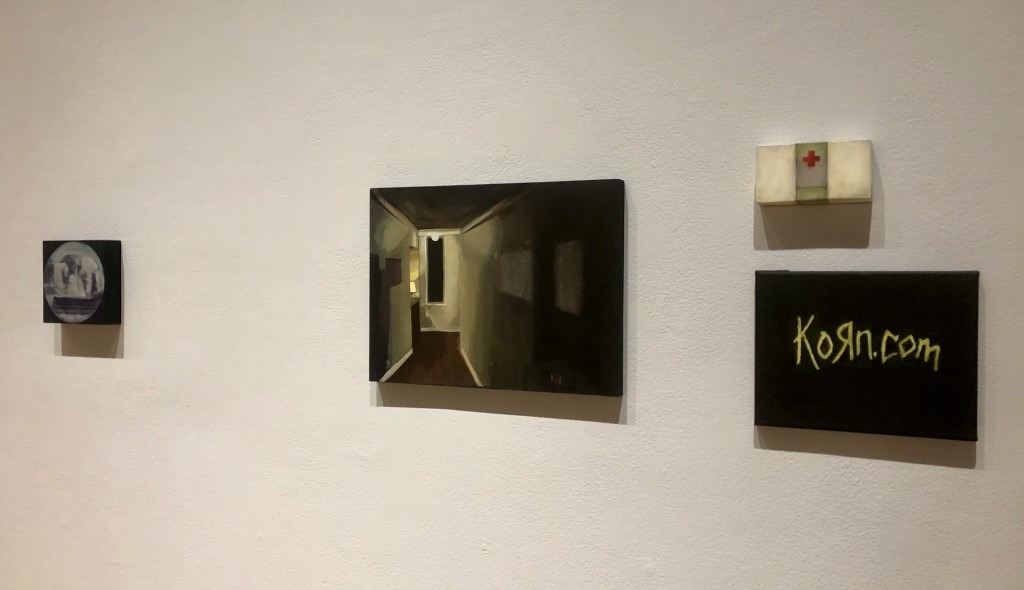
It is a worthwhile trip to see people taking the leap of faith into the unknown. This exhibition is their calling card.
And to quote Antoine de Saint-Exupérey’s The Little Prince, who has traveled many worlds. . . “It is only with the heart that one can see rightly; what is essential is invisible to the eye.”
Which is humorously ironic as we’re talking about visual arts, but that’s what art does.
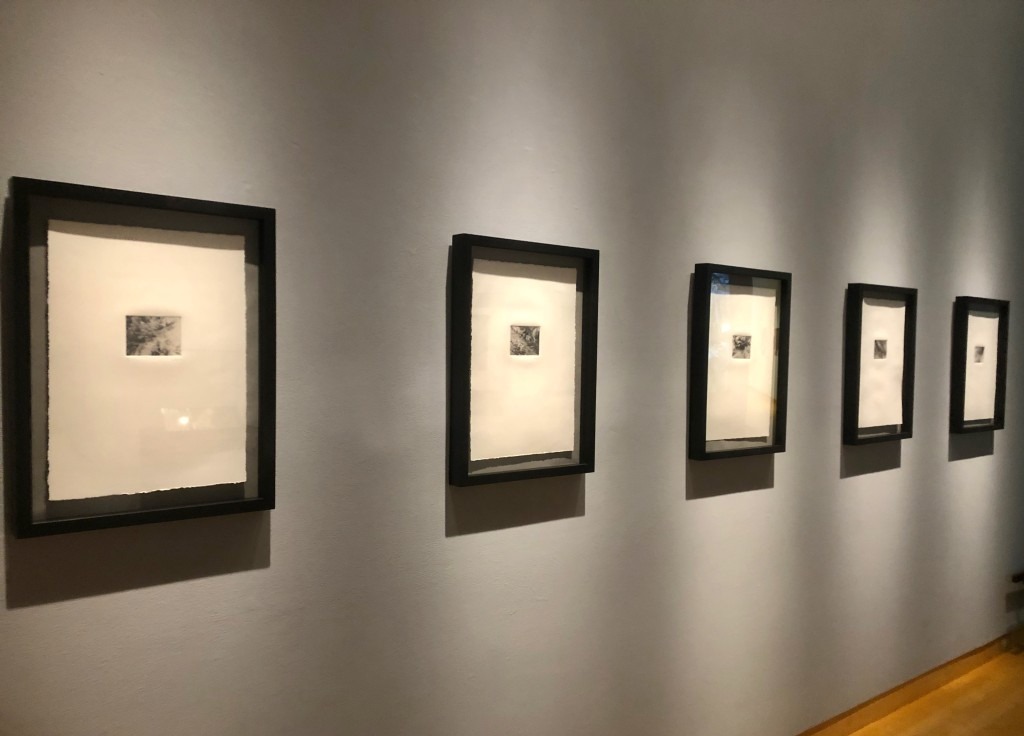
P.S.: While you’re at CAM pondering the MFA artists’ accomplishments, also take a stroll next door to the Carolyn M. Wilson Gallery in the Fine Arts Studio building – it’s run and programmed for students in the School of Art & Art History.
Some awesome paintings there, in the Annual Juried Student Show that just closed – but The Colors the Hand Makes, a BFA thesis exhibition, runs April 14-28 from 11 am to 3 pm Mondays through Thursdays.
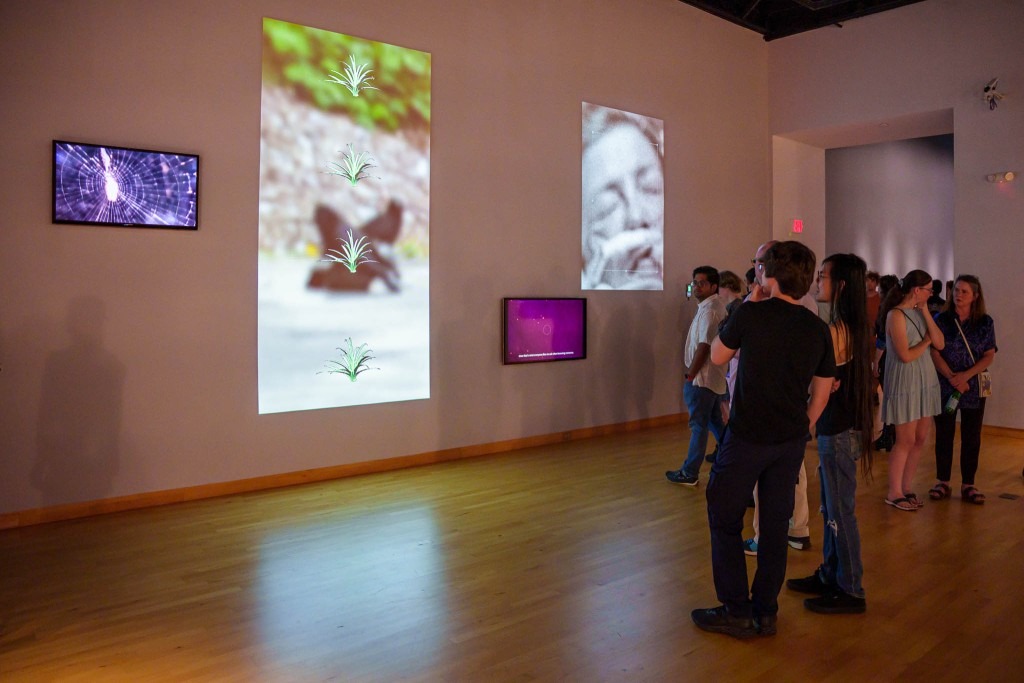
Visual and Literary Arts Collaboration
On April 13 from 6-8 pm you can hear a free performance of Saying It Out Loud, A Reading of Original Poetry at the USF Contemporary Art Museum.
Graduate students in USF’s Craft of Poetry course will share poems created in response to the visual art in the Someday You’ll Have to Say It Out Loud exhibit. Here are a selection that the authors shared.
Backwards Sonnet, by Audrey Rose
After Untitled, an oil painting by Trinity Oribio (2023)
The poem starts with you
. . . . . unbuttoning my name
with your teeth. I didn’t know you
. . . . . could unzip an O—say it slow
enough you can stop time—
. . . . . your mouth a flash of light
too bright for us to see the end.
Too bright for us to see. The end:
. . . . . your mouth a flash of light—
enough. You can stop. Time
. . . . . could unzip an O—say it slow
with your teeth. I didn’t know you
. . . . . unbuttoning my name.
The poem starts with you.
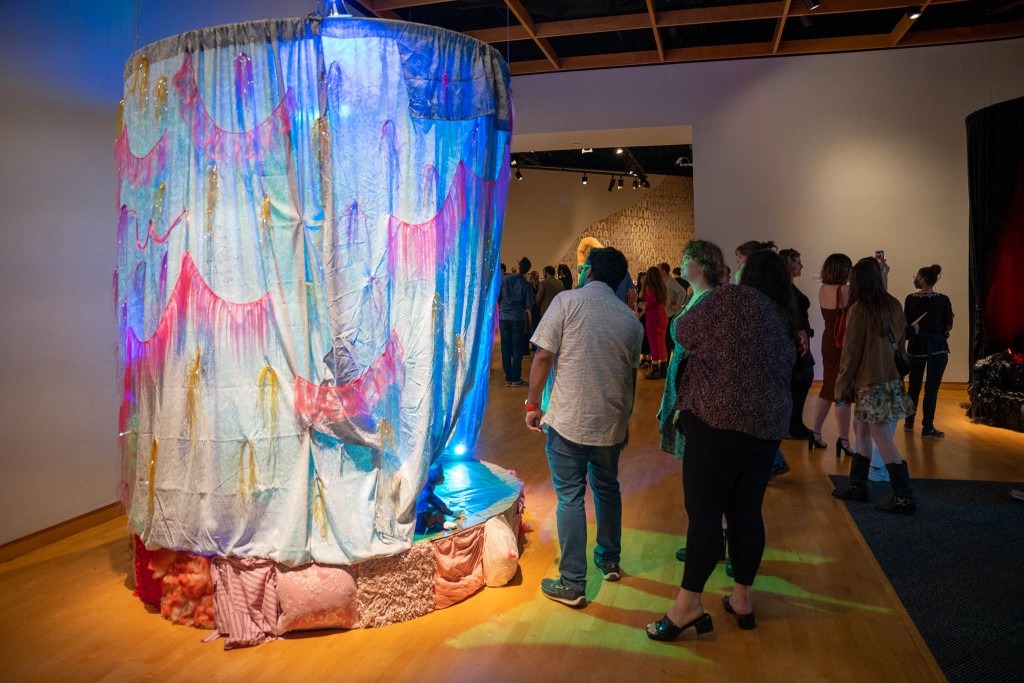
The Observer Effect, by Erin Olds
After Paradise Lakes, an installation by Kai Holyoke (2023)
The Observer Effect states
an object’s trajectory is changed
from what it would have been
had no one been observing it.
Like when you check the air
pressure in tires and some
spires out, just a release
that comes from the needle
inserted into the spout.
Like a thermometer that takes
just a little energy for the mercury
to do its work and measure
the temperature. It’s changed
just by someone watching.
A gradual growth is occurring
slowly, like the scale whose
numbers increase
with the calendar. It happens
over time—a course of weeks
or years or donuts. One beer
in a season.
The feline judges just as cats do.
Their superiority stunted by their
size, their breeding to be subservient,
despite their odor that wreaks
dominance, even if he stays
the size of a kitten. He knows
about your pending divorce,
about your dead bedroom, your
post-marital counseling.
The money you would have
spent on a dinner date is spent
on Meow Mix. The five minutes
awkwardly talking to your
estranged spouse is spent
cleaning litter. The dusty,
cluttered bathroom countertop
stays stray while he watches
it accumulate.
We don’t notice
we are being observed.
We don’t know we’re
being changed.
We don’t know how to
be noticed and still
remain the same.

Self-Portrait as a Comically Large Heart, by Mara Beneway
After Trinity Oribio’s For the One Who is Most Beautiful (2023)
Joellen’s favorite jeans were slit
all the way up & had skinny leather strings,
which crisscrossed, keeping her thighs
denim tight. Joellen wore butterfly hair clips
& had a baby blue beetle, a punch
bug, with a bunch of flowers swiped
from the playground on the VW’s dash.
This is a babysitter still life.
Caitlyn’s BF had green hair & he loved her
& we knew that cuz he stole her a seashell
necklace from a tourist shop in Myrtle Beach.
Caitlyn introduced me to Evanescence & the word
bitch. That girl Michelle’s mom fed us American
cheese & bologna on white bread.
Lisa Chang had a bellybutton bedazzled
by a long cherry earring & the one cheerleader
chick taught us how to kiss with a mirror.
One college summer, when we saw Kelly
at the bar, she admitted to stealing our parents’
beer whenever she watched us. We laughed
because we did the same thing once we turned twelve
& morphed from babies to babysitters.
Destiny’s Child on the radio & pockets littered
with red hots. We smudged our lashes black &
skinned our kneecaps & with our shoulder blades
we caught the last purply light of summer.
A babysitter still life, a self-portrait.
This is a babysitter love letter to the girls
who made me, which is a love letter to myself.
Most of my girls are mothers now,
they no longer need me for practice,
they’ve been overwhelmed by placentas
& umbilical cords & emergency contacts.
One of them is dead:
Jessica, Joellen’s sister, mother of three.
In third grade, I had strep throat
& to make me feel better, a teenage Jessica
gave me the necklace she wore every day:
a simple silver chain, a very permanent thing,
holding up a delicate, comically large pendant
in the shape of a heart.
Exhibits from the Museum of the Holy Trinity, by Alicia Watkinson
After For The One Who Is The Most Beautiful, an installation by Trinity Oribio (2023)
0. I can’t tell you anything new about the heart—you can’t tell a heart to itself.
25. In neon pink bedsheets the light shines through like cloud shaped curtains, a bed of spinning childlike dreams.
78. The parrot streams were bought for a visitor’s 13th birthday party, holographic in nature, parrots and pink blue orange yellow flowers, they shimmer back and forth fallen after everyone has eaten all the cake.
196. In the gift shop you can take away your own snow globe-esque crystal ball that reads: to the one who is the most beautiful, red red roses, shake the petals down and around like bouncy balls and tell yourself you, you are the most beautiful.
54. When you begin to look closely, you notice everyone looking back at you and how uneven their eyes are. Tilted into questioning and looking, the love of looking.
199. In the lobby you can place all your belongings on a turquoise colored metal shelf. The guard watches over them and only every once in a while do they peek in your backpack.
116. Upon entering the museum you might have a sense you have lost a part of yourself. If that is the case kneel at the altar of Saint Jude, patron saint of lost causes. The rosemary beads and statues of hands clasp in prayer and ask for forgiveness.
77. The museum phone rings. Someone, in some office says I must answer the call.
133. In the gift shop you find heart shaped boxes of chocolates wrapped in red cellophane, reflecting your deepest desires back to you. There are cosmic ponies and dozens of roses and crystal door knobs with no key.
213. The last room in the museum holds the exhibition of the history of the heart shape. This here is an 11 ft tall heart, won’t you ask it what makes it perfect?
90. This here is a portrait of a disassembled heart. Threatening to recompose itself. When it is assembled it forms another flawless heart, it’s allowed to spin, draped in white satin, it shines, it shimmers. Love goes on and on and on and on and on forever, the whole thing, a spectacle.
Note: The line “I can’t tell you anything new about the heart—you can’t tell a heart to itself” is a variation on a line from Natalie Diaz’s poem “Exhibits from the American Water Museum.”
– Alicia Watkinson is also one of the MFA artists in the visual exhibition, Someday You’ll Have To Say It Out Loud.



